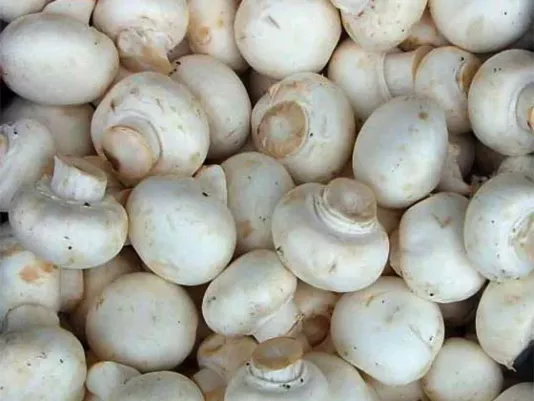Potatoes Stuffed with Chicken
Potatoes stuffed with chicken is a recipe from Azerbaijani cuisine that is prepared for the festive table for Novruz.

Champignons are a versatile ingredient that combines natural aroma, meaty texture, and incredible culinary flexibility. Over the years, I’ve learned to recognize their condition not only by sight but also by touch: a fresh cap is always firm, free of spots or cracks; the stem is white with a clean, moist cut; and the aroma is light, nutty, with no hint of mustiness. For me, champignons are a kind of tuning fork of flavor, able to adjust to the mood of a dish: in a salad, they add freshness; in a sauce, depth; in a casserole, tenderness. I love when they caramelize to a golden hue while staying juicy inside. At that moment, their true nature reveals itself – pure, expressive, and natural. They respond well to spices, butter, and herbs, yet always retain their character.
Over the years of cooking, I’ve realized that the quality of champignons determines half the success of a dish. The best mushrooms have firm caps without cracks, stems without slime, and gills under the cap that are light or slightly creamy. If they’ve darkened, it signals aging. I always check the aroma – fresh champignons smell clean, with a faint nutty tone. The surface should be naturally moist, not sticky. Mushrooms that have spent a few days in the fridge lose density and don’t hold their shape well during cooking. When buying them at the market, I pay attention to storage temperature: if the tray sits out in the open without cooling, the aroma quickly turns stale. Freshness is key because even slight aging reduces the mushrooms’ ability to retain juice. At home, I store them in a paper bag, unwashed until cooking, so they don’t absorb moisture. Properly selected mushrooms have an even texture and release their aroma only after heating, ensuring a clean, rich taste.
In my experience, the most common mistake is over-washing champignons under running water. Mushrooms act like sponges, quickly absorbing liquid, so instead of frying, they start to steam. I always clean them with a damp cloth or soft brush to remove soil. If the surface is slightly darkened, you can gently peel off the thin skin from the cap – it gives the dish a more elegant look. When champignons are large, I remove the stem and chop it separately – it adds richness to sauces or fillings. Before slicing, the mushrooms should be dry so the cuts stay clean and the juice doesn’t leak prematurely. I often chill them for a few minutes before cutting – it helps achieve precise, evenly thick pieces. Proper preparation preserves not only texture but also aroma, which activates during heating. If you skip this step, the finished dish will lose firmness and become watery. For me, it’s a principle: care for the ingredient must be delicate because true flavor harmony is built from small, thoughtful actions.
The secret to a rich mushroom flavor lies in proper temperature. I always place champignons only on a well-heated pan with a small amount of fat. If the heat is too low, they release juice and start to stew instead of sear, losing aroma. On medium-high heat, each piece caramelizes quickly, forming an appetizing crust. It’s important not to overcrowd the pan – it’s better to cook in batches to preserve texture. When tender mushrooms are needed for a sauce or cream soup, I add a small amount of butter at the end and briefly heat under a lid. For baking, even heat is essential: 180-190°C (356-374°F) allows champignons to cook through without drying out. Over the years, I’ve learned to recognize doneness by aroma – when it turns nutty and rich, it means the proteins have set but the flesh remains juicy. If overcooked, champignons become rubbery. Temperature control is the foundation of precision, and I always emphasize this to my students.
Champignons absorb flavors wonderfully, so I always think about the balance of spices and fats. Butter adds softness, while olive oil enhances their light nuttiness. Garlic, thyme, and sage pair perfectly with mushrooms, as do small amounts of white wine or broth for deglazing the pan. Over the years, I’ve noticed that acidity helps brighten the flavor – a few drops of lemon juice or a spoonful of sour cream balance the richness. For contrast, I like combining champignons with caramelized onions or crispy bacon, but I always keep proportions in check: mushrooms should remain the star. In warm salads, they pair beautifully with grains, and in sauces, with cream or thick reductions. I love experimenting with textures: sautéed pieces alongside purée made from the same mushrooms create depth. Each combination should reveal the natural aroma rather than mask it because that aroma is the essence of this ingredient.
Many people underestimate the importance of proper champignon storage. I never keep them in sealed plastic containers – they “suffocate”, develop slime, and acquire off odors. The best solution is a paper bag in the refrigerator, where they can breathe. The storage period shouldn’t exceed three days, and if I notice the first signs of darkening or excess moisture, I use them immediately in cooked dishes. Raw champignons shouldn’t be left at room temperature: even a few hours can trigger bacterial growth. Another common mistake is reheating cooked mushrooms. Once cooled, their proteins change structure, and when reheated, the taste becomes bitter. In my practice, I always cook only what’s needed and store leftovers for no more than a day. It’s also important to avoid aluminum cookware for cooking or marinating – the acid in mushrooms reacts with the metal, spoiling the aroma. Following these simple rules ensures not only safety but also consistently high quality of prepared dishes.